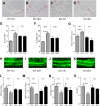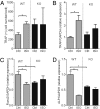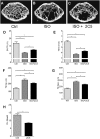Sympathetic control of bone mass regulated by osteopontin
- PMID: 21990347
- PMCID: PMC3203767
- DOI: 10.1073/pnas.1109402108
Sympathetic control of bone mass regulated by osteopontin
Abstract
The sympathetic nervous system suppresses bone mass by mechanisms that remain incompletely elucidated. Using cell-based and murine genetics approaches, we show that this activity of the sympathetic nervous system requires osteopontin (OPN), a cytokine and one of the major members of the noncollagenous extracellular matrix proteins of bone. In this work, we found that the stimulation of the sympathetic tone by isoproterenol increased the level of OPN expression in the plasma and bone and that mice lacking OPN (OPN-KO) suppressed the isoproterenol-induced bone loss by preventing reduced osteoblastic and enhanced osteoclastic activities. In addition, we found that OPN is necessary for changes in the expression of genes related to bone resorption and bone formation that are induced by activation of the sympathetic tone. At the cellular level, we showed that intracellular OPN modulated the capacity of the β2-adrenergic receptor to generate cAMP with a corresponding modulation of cAMP-response element binding (CREB) phosphorylation and associated transcriptional events inside the cell. Our results indicate that OPN plays a critical role in sympathetic tone regulation of bone mass and that this OPN regulation is taking place through modulation of the β2-adrenergic receptor/cAMP signaling system.
Conflict of interest statement
The authors declare no conflict of interest.
Figures







Similar articles
-
Unloading induces osteoblastic cell suppression and osteoclastic cell activation to lead to bone loss via sympathetic nervous system.J Biol Chem. 2005 Aug 26;280(34):30192-200. doi: 10.1074/jbc.M504179200. Epub 2005 Jun 16. J Biol Chem. 2005. PMID: 15961387
-
Deletion of OPN in BSP knockout mice does not correct bone hypomineralization but results in high bone turnover.Bone. 2019 Mar;120:411-422. doi: 10.1016/j.bone.2018.12.001. Epub 2018 Dec 5. Bone. 2019. PMID: 30529011
-
Enhancement of osteoclastic bone resorption and suppression of osteoblastic bone formation in response to reduced mechanical stress do not occur in the absence of osteopontin.J Exp Med. 2001 Feb 5;193(3):399-404. doi: 10.1084/jem.193.3.399. J Exp Med. 2001. PMID: 11157060 Free PMC article.
-
Pharmacological topics of bone metabolism: the physiological function of the sympathetic nervous system in modulating bone resorption.J Pharmacol Sci. 2008 Apr;106(4):542-6. doi: 10.1254/jphs.fm0070227. J Pharmacol Sci. 2008. PMID: 18431037 Review.
-
Adrenergic regulation of bone metabolism: possible involvement of sympathetic innervation of osteoblastic and osteoclastic cells.Microsc Res Tech. 2002 Jul 15;58(2):77-84. doi: 10.1002/jemt.10121. Microsc Res Tech. 2002. PMID: 12203706 Review.
Cited by
-
Bone marrow adipose tissue does not express UCP1 during development or adrenergic-induced remodeling.Sci Rep. 2019 Nov 22;9(1):17427. doi: 10.1038/s41598-019-54036-x. Sci Rep. 2019. PMID: 31758074 Free PMC article.
-
Osteopontin in Bone Metabolism and Bone Diseases.Med Sci Monit. 2020 Jan 30;26:e919159. doi: 10.12659/MSM.919159. Med Sci Monit. 2020. PMID: 31996665 Free PMC article. Review.
-
Osteoblast-specific expression of the fibrous dysplasia (FD)-causing mutation Gsα(R201C) produces a high bone mass phenotype but does not reproduce FD in the mouse.J Bone Miner Res. 2015 Jun;30(6):1030-43. doi: 10.1002/jbmr.2425. J Bone Miner Res. 2015. PMID: 25487351 Free PMC article.
-
Mechanisms of osteopontin-stabilized amorphous calcium phosphate calcification in benign and pre-malignant breast disease.Sci Rep. 2025 Jul 4;15(1):23849. doi: 10.1038/s41598-025-08903-5. Sci Rep. 2025. PMID: 40615470 Free PMC article.
-
Impaired Vestibular Function and Low Bone Mineral Density: Data from the Baltimore Longitudinal Study of Aging.J Assoc Res Otolaryngol. 2016 Oct;17(5):433-40. doi: 10.1007/s10162-016-0577-5. Epub 2016 Jul 22. J Assoc Res Otolaryngol. 2016. PMID: 27447468 Free PMC article.
References
-
- Kanis JA, et al. The components of excess mortality after hip fracture. Bone. 2003;32:468–473. - PubMed
-
- Lanyon L, Skerry T. Postmenopausal osteoporosis as a failure of bone's adaptation to functional loading: a hypothesis. J Bone Miner Res. 2001;16:1937–1947. - PubMed
-
- Ehrlich PJ, Lanyon LE. Mechanical strain and bone cell function: a review. Osteoporos Int. 2002;13:688–700. - PubMed
-
- Noda M, editor. Mechanosensing Biology. Tokyo: Springer; 2011.
Publication types
MeSH terms
Substances
Grants and funding
LinkOut - more resources
Full Text Sources
Other Literature Sources
Molecular Biology Databases
Research Materials

